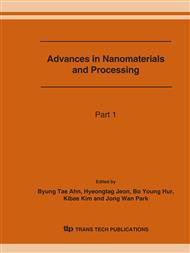p.139
p.143
p.147
p.153
p.157
p.161
p.165
p.169
p.173
Removal of Slurry Residues in Tungsten Plug during Chemical Mechanical Planarization
Abstract:
One of key processes in tungsten (W) CMP is to remove slurry particles inside W plug after CMP. In general, HF cleaning is well known to remove the slurry residue particles in W plugs. HF chemistry lifts off the particles by etching the plug during scrubbing and effectively removes particles. It is sometimes impossible to apply HF chemisty on W plug due to the degradation of electrical characteristics of a device. In this paper, a post W CMP cleaning process is proposed to remove residue particles without applying HF chemistry. After W CMP, recessed plugs are created, therefore they easily trap slurry particles during CMP process. These particles in recessed plug are not easy to remove by brush scrubbing when NH4OH chemistry is used for the cleaning because the brush surface can not reach the recessed area of plugs. Buffing with oxide slurry was followed by W CMP due to its high selectivity to W. The buffing polishes only oxide slightly which creates higher plug profiles than surrounding oxide. Higher profiles make the brush contact much more effectively and result in a similar particle removal efficiency even in NH4OH cleaning to that in HF brush scrubbing.
Info:
Periodical:
Pages:
157-160
Citation:
Online since:
June 2007
Authors:
Keywords:
Price:
Сopyright:
© 2007 Trans Tech Publications Ltd. All Rights Reserved
Share:
Citation:


